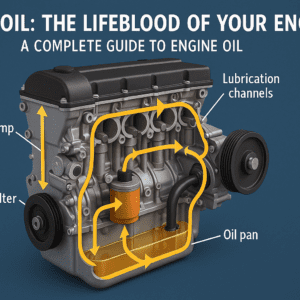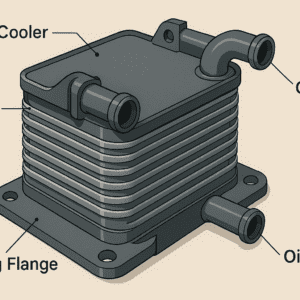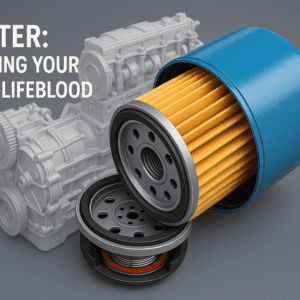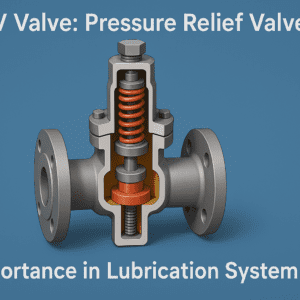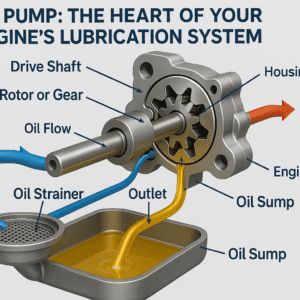
What is Lubrication System?
Lubrication System is the process of applying a substance between two moving parts to reduce friction, wear and heat generated during their interaction. As a result, smooth operation and protect components from damage and corrosion.
Purpose Of Lubrication System
- Reduce Friction: Lubrication System reduces friction between the moving parts to a minimum level, thereby minimising power loss.
- Minimize Wear and Tear: Engine parts undergo wear and tear during its operation. The wearing of moving parts is reduced due to lubrication.
- Cleaning Effect: The lubricating oil dissolves many impurities like carbon particles during its circulation. This oil is purified by allowing it to pass through filters.
- Cooling Effect: When lubricating oil circulates inside the engine. It takes away heat from the moving parts. This heat is deliverer to the surrounding air through the crankcase.
- Sealing Effect: The high-pressure gases inside the cylinder may leak out towards the side of the crankcase prevented by lubricant.
- Prevent Corrosion: Lubricating oil protects surfaces from rust and oxidation.
- Smooth Operations: Reduce noise and vibration during operation in machinery.
Components of Lubrication System
(a) Oil Pan (Sump)

The oil sump, also known as the oil pan, plays a crucial role in the lubrication system of an internal combustion engine.
- Primary Function: Oil storage, cooling of engine oil, oil collection, oil supply, and oil level monitoring.
- Location: At the bottom of engine.
(b) Sump Strainer

The sump strainer is an essential component of the engine lubrication system. Its primary function is to ensure that the oil pumped from the sump to the engine is free from debris and contaminants.
- Function: Filtration of contaminants, protection of the oil pump, and ensuring oil flow.
- Location: Inside the oil sump.
(c) Oil Filter

The oil filter is a critical component of the engine’s lubrication system, designed to remove impurities and contaminants from the engine oil.
- Function: Filtration of impurities, protection of engine components, maintaining oil quality, bypass valve function, and extending engine life.
- Location: The oil filter is typically located on the engine block and its exact location can vary depending on the engine design and manufacturer.
(d) Oil Pump

The oil pump is a main component of the lubrication system in an internal combustion engine. It ensures that engine oil is circulated under pressure to all the moving parts.
- Function: Oil circulation, oil pressurization, heat dissipation, and debris removal.
- Location: The oil pump is typically located inside the engine, often in close proximity to the oil sump.
(e) PRV (Pressure Relief Valve)

PRV stands for Pressure Relief Valve, which is a safety device used in the lubrication system of an internal combustion engine to regulate and maintain the oil pressure within a specified range. The PRV ensures that the oil pressure does not exceed safe limits, protecting the oil pump, seals, and other engine components from potential damage caused by excessive pressure.
- Function: Maintains Optimal Oil Pressure, prevents overloading of the oil pump, and protects engine components.
- Location: The Pressure Relief Valve (PRV) is typically located within the oil pump or in the oil system, depending on the engine design.
Property of Lubricants
The properties of lubricants can be categorized into physical, chemical, and performance aspects. These properties determine their efficiency and suitability for various applications.
1. Physical Properties
(a) Viscosity: Measure of a lubricant’s resistance to flow.
- Importance: Affects the lubricant’s ability to form a film between moving parts.
- Example: High viscosity oils are used in heavy load engines and low viscosity oils are preferred for high-speed engines.
(b) Viscosity Index (VI): Indicates how much the viscosity changes with temperature.
- Importance: High viscosity index means the lubricant maintains its viscosity over a wide range of temperature.
(c) Flash Point: The lower temperature at which the lubricant emits vapors that can ignite.
- Importance: Indicates safety for high temperature applications.
(d) Density: The weight of the lubricant per unit volume, affecting its flow and compatibility with materials.
(e) Pour Point: The lowest temperature at which the lubricant remains fluid. Critical for low temperature applications.
(f) Thermal Conductivity: The ability to transfer heat, aiding in cooling applications.
(g) Surface Tension: Determines the lubricants ability to spread over a surface.
2. Chemical Properties
(a) Oxidation Stability: Resistance to chemical degradation in the presence of oxygen, preventing sludge formation.
(b) Corrosion Resistance: Ability to protect metal surfaces from rust and corrosion.
(c) Acidity/Alkalinity: Total acid number measures acidic content and total base number measures alkalinity for neutralizing acids.
(d) Additive Compatibility: Ability to work effectively with additive like anti wear agents, detergents, and Anti dispersants.
(e) Thermal Stability: Resistance to breaking down at elevated temperatures.
3. Performance Properties
(a) Anti Wear Properties
(b) Extreme Pressure Properties
(c) Friction Reduction
(d) Film Strength
(e) Shear Stability
(f) Foaming Tendency
Types of Lubrication System
Lubrication systems are methods or mechanisms used to deliver lubricant to machinery or engine components to reduce friction, wear, and heat.
(a) Manual Lubrication System: Lubricant is applied manually using tools like grease guns, brushes, or oil cans.

- Applications: Small machines, low-duty equipment, or components that don’t require continuous lubrication.
- Advantages: Simple and inexpensive.
- Disadvantages: Time-consuming and inconsistent application.
(b) Splash Lubrication System: Components, such as gears or connecting rods, splash lubricant from a reservoir or sump.

- Applications: Internal combustion engines, gearboxes, and small machines.
- Advantages: Simple and effective for low to moderate speeds.
- Disadvantages: Limited lubrication at very high or very low speeds.
(c) Pressure Feed Lubrication System: Uses a pump to deliver lubricant under pressure to components.

- Applications: High-performance engines, turbines, compressors, and industrial machinery.
- Advantages: Provides consistent and controlled lubrication.
- Disadvantages: More complex and expensive to maintain.
(d) Oil Mist Lubrication System: Converts oil into a fine mist, which is directed to the components requiring lubrication.

- Applications: Bearings, high-speed machinery, and enclosed systems.
- Advantages: Minimal lubricant consumption, good for hard-to-reach areas.
- Disadvantages: Requires specialized equipment and careful monitoring.
(e) Grease Lubrication System: Grease is applied to components, usually through grease fittings or packing.

- Applications: Bearings, sliding surfaces, and heavy-duty equipment.
- Advantages: Stays in place, good for sealed or infrequent maintenance areas.
- Disadvantages: Not ideal for high-speed or high-temperature applications.
(f) Centralized Lubrication System: Delivers lubricant to multiple points from a central reservoir or pump.

Types of Centralized Lubrication System:
(i) Single-Line Lubrication System
(ii) Dual-Line Lubrication System
(iii) Progressive Lubrication System
- Applications: Large industrial machinery, heavy equipment, and production lines.
- Advantages: Automated, reduces downtime, and ensures uniform lubrication.
- Disadvantages: Initial setup cost is high.
(g) Dry Sump Lubrication System: Uses an external reservoir to store oil, with pumps to circulate it through the system.

- Applications: High-performance engines (e.g., race cars, aircraft).
- Advantages: Improved cooling, reduces oil foaming, allows flexible engine design.
- Disadvantages: More complex and expensive.
(h) Wet Sump Lubrication System: Oil is stored in the crankcase and pumped directly to the components.

- Applications: Most internal combustion engines.
- Advantages: Simpler design and easier maintenance.
- Disadvantages: Less efficient cooling and higher risk of oil foaming.
Types of Lubricants
1. Animal Oil

Lubricants are derived from animal fats or oils and were historically used for lubrication in various applications.
- Source: Derived from animal fats, including lard (pig fat), tallow (beef fat), and fish oil.
Applications of Animal Oil Lubricants:
- Textile Industry: Used to lubricate machinery and preserve fibers.
- Railways: Applied on axles and bearings in early locomotives.
- Weapons: Greased firearm mechanisms and metal parts.
- Leather Industry: Conditioning and preserving leather products.
Advantages of Animal Oil Lubricants:
- Natural Origin: Suitable for industries focusing on organic or sustainable products.
- Eco-Friendly: Non-toxic and decomposes naturally without harmful residues.
- Adhesion: Excellent clinging properties for surfaces, even in low-speed applications.
Disadvantages of Animal Oil Lubricants:
- Temperature Sensitivity: Limited use in high-temperature or extreme environments.
- Cost and Availability: Production is often costlier than synthetic options.
Read More: Engine
2. Vegetable Oil

Vegetable oil lubricants are derived from plant-based oils and are known for their eco-friendly, renewable, and biodegradable properties.
- Source: Extracted from plants such as soybean, rapeseed (canola), sunflower, castor, palm, coconut, and olive.
Applications of Vegetable Oil Lubricants
- Industrial Applications: Hydraulic systems, compressors, and gear oils in eco-sensitive areas.
- Agriculture and Forestry: Used in tractors, chainsaws, and other equipment where contamination of soil or water must be avoided.
- Food-Grade Lubricants: Suitable for food processing equipment due to their non-toxic and safe nature.
Advantages of Vegetable Oil Lubricants
- Eco-Friendly: Non-toxic, biodegradable, and renewable.
- Superior Lubricity: Excellent friction reduction compared to mineral oils.
- High Viscosity Index: Performs well over a range of temperatures without significant viscosity loss.
- Sustainable: Derived from renewable sources, reducing dependence on petroleum.
Disadvantages of Vegetable Oil Lubricants
- Oxidation and Rancidity: Prone to degradation when exposed to air, moisture, or heat.
- Temperature Sensitivity: Limited performance at extreme high or low temperatures compared to synthetics.
- Cost: Higher production costs compared to mineral oils.
- Limited Availability: Some specialized formulations may not be widely available.
3. Mineral Oil

Mineral oil lubricants are derived from refining crude petroleum. They are among the most widely used lubricants due to their cost-effectiveness, versatility, and availability. They serve as a base for many industrial, automotive, and household lubrication applications.
- Source: Obtained through fractional distillation and refining of crude oil.
Types of Mineral Oil Lubricants
- Base Oil
- White Oil
- Speciality Oil
Applications of Mineral Oil Lubricants
- Automotive: Engine oils, gear oils, and transmission fluids.
- Industrial: Hydraulic systems, compressors, turbines, and machinery lubrication.
- Metalworking: Cutting, grinding, and machining fluids.
- Textiles: Lubricants for spinning, weaving, and knitting machines.
- Household: Sewing machines, locks, and small appliances.
Advantages of Mineral Oil Lubricants
- Cost-Effective: Cheaper than synthetic and biodegradable alternatives.
- Versatility: Suitable for a wide range of applications.
- Ease of Availability: Readily available in various grades and formulations.
- Customizability: Easily enhanced with additives (e.g., anti-wear, antioxidants, viscosity improvers).
Disadvantages of Mineral Oil Lubricants
- Lower Thermal Stability: Breaks down at higher temperatures compared to synthetics.
- Oxidation and Sludge Formation: Prone to oxidation, leading to deposits and sludge.
- Environmental Impact: Non-biodegradable, potential for groundwater contamination.
- Performance Limitations: Narrower operating temperature range compared to synthetic oils.
4. Grease

Grease is a semi-solid lubricant made up of base oil, a thickening agent, and additives. It is widely used in applications where liquid lubricants cannot be retained or are impractical. Grease offers excellent lubrication for components that operate under high loads, intermittent motion, or extreme environmental conditions.
Properties of Grease
- Adhesion: Sticks to surfaces, ensuring lubrication even in high-pressure environments.
- Drop Point: The temperature at which grease becomes liquid, indicating its thermal stability.
- Water Resistance: Protects components from corrosion in wet or humid conditions.
- Sealing Capability: Acts as a barrier against contaminants like dirt and moisture.
Types of Grease
(a) Lithium Grease:
- Multi-purpose, high-temperature tolerance, and good water resistance.
- Commonly used in automotive and industrial applications.
(b) Calcium Grease:
- Suitable for marine applications.
(c) Aluminum Complex Grease:
- High-temperature performance and excellent water resistance.
- Used in heavy machinery and extreme conditions.
(d) Polyurea Grease:
- Long life, good oxidation stability, and high temperature resistance.
- Used in electric motors and sealed-for-life applications.
(e) Molybdenum Disulfide Grease:
- Enhanced extreme pressure performance, reducing wear in high-load applications.
- Commonly used in bearings and sliding mechanisms.
(f) Silicone Grease:
- Chemically inert and resistant to extreme temperatures.
- Used in electrical and plastic applications.
Applications of Grease
- Automotive: Wheel bearings, chassis components, and suspension systems.
- Industrial: Machinery, gears, and conveyors.
- Aerospace: High-performance greases for aircraft components.
- Household: Door hinges, locks, and small appliances.
- Marine: Lubrication of components exposed to water and salt.
Advantages of Grease
- Stays in Place: Does not drip or run off, even under vertical or angled applications.
- Extended Lubrication: Reduces the frequency of re-application.
- Sealing Properties: Protects against contamination and water ingress.
- High Load Capacity: Performs well under heavy loads and shock conditions.
Disadvantages of Grease
- Heat Dissipation: Less effective at dissipating heat compared to oils.
- Limited Speed Range: May cause drag in high-speed applications.
- Cleanliness: Can attract dirt and debris, leading to contamination.
- Not Suitable for All Applications: Inappropriate for systems requiring continuous lubrication or cooling.
Grease Selection Criteria
- Operating temperature range.
- Load-bearing requirements.
- Speed of moving components.
- Environmental conditions (e.g., water, dust, chemicals).
- Compatibility with materials (e.g., plastics, metals).
Maintenance and Storage Tips
- Use clean tools to apply grease to prevent contamination.
- Store in a cool, dry place to prevent degradation.
- Avoid mixing greases with different thickeners or base oils.
5. Solid Lubricants

Solid lubricants are materials used to reduce friction and wear between surfaces without requiring a liquid or semi-solid medium. They are especially effective in extreme conditions where traditional lubricants (like oils or greases) may fail due to high temperatures, vacuum, or contamination.
Characteristics of Solid Lubricants
(i) Dry Lubrication: Operates without liquid or semi-solid lubrication.
(ii) High-Temperature Resistance: Effective in environments exceeding the thermal limits of oils and greases.
(iii) Chemical Stability: Resistant to oxidation, corrosion, and chemical degradation.
(iv) Low Friction Coefficients: Provides smooth sliding action even under extreme conditions.
Common Types of Solid Lubricants:
(i) Graphite
(ii) Molybdenum Disulfide
(iii) Polytetrafluoroethylene
(iv) Boron Nitride
(v) Metallic Lubricants
(vi) Tungsten Disulfide
Advantages of Solid Lubricants
- Wide Operating Range: Effective in extreme temperatures and pressure conditions.
- No Leakage: Suitable for clean environments, as they do not drip or evaporate.
- Chemical Resistance: Resistant to corrosive environments and solvents.
- Long-Lasting: Requires less frequent re-application than traditional lubricants.
- Vacuum Compatibility: Performs well in space or vacuum conditions.
Disadvantages of Solid Lubricants
- Limited Load Carrying Capacity: Not suitable for applications with very high dynamic loads.
- Initial Application Cost: Higher cost for coatings or incorporation into systems.
- Adhesion Issues: May require special application methods (e.g., bonding to surfaces).
- Ineffectiveness in Certain Conditions: Some, like graphite, depend on moisture to maintain performance.
Applications of Solid Lubricants
- Aerospace: Bearings, gears, and sliding mechanisms in satellites and spacecraft.
- Automotive: Engine components, piston rings, and braking systems.
- Machinery: High-temperature or heavy-load equipment.
- Military: Weapons, tanks, and defense equipment.
- Electronics: Components where liquid lubricants might cause short circuits.
- Food Industry: PTFE is used for non-toxic, food-grade lubrication.
Comparison: Solid vs. Liquid Lubricants
| Property | Solid Lubricants | Liquid Lubricants |
| Operating Conditions | Extreme temperatures, vacuum | Moderate to extreme |
| Application | Dry environments, clean systems | Wide range |
| Reapplication | Rarely required | Frequent |
| Leakage Risk | None | possible |
| Cost | Higher upfront | Lower upfront |
Troubleshooting in Lubrication System
Excessive Oil Consumption
| Defect | Remedy |
| Oil Entering Combustion Chamber | Check & Replace |
| Sticky Piston Ring | Clean Ring |
| Worn Piston Ring | Replace Piston Ring |
| Ring Gap Improper | Reset Gap |
| Worn Out Valve Stem Seal | Replace Valve Stem Seal |
| Worn Valve Stem | Replace Valve Stem |
High Oil Pressure in Lubrication System
| Defect | Remedy |
| Oil Level High | Drain excessive Oil |
| Wrong Grade of Oil | Replace Oil |
| PRV Jammed in closed position | Repair PRV |
| Oil Filter Burst | Replace Oil Filter |
| Less clearance in big end & Main bearing | Adjust Cearance |
Low Oil Pressure in Lubrication System
| Defect | Remedy |
| Low oil level in sump | Top up oil level |
| Oil pump faulty | Repair/Replace oil pump |
| Wrong grade of oil | Change oil |
| PRV (Pressure Relief Valve) faulty | Repair/Replace PRV |
| Wear in crankshaft bearing | Repair/Replace Crankshaft bearing |
| Oil Pressure Gauge faulty | Replace Oil Pressure Gauge |
Main Bearing Noisy
| Defect | Remedy |
| Insufficient Oil Supply | Check System |
| Excessive bearing clearance | Measure & Adjust |
| Excessive end play of crankshaft | Check, Repair |
Engine Overheat
| Defect | Remedy |
| Low Oil Level | Top Up Oil |
| Oil Filter Clogged | Replace Oil Filter |
| Faulty Oil Pump | Repair & Replace Oil Pump |
| Faulty PRV | Replace PRV |
| Wrong Grade of Oil | Fill Correct Grade of Oil |
| Oil Dirty | Change Oil |
| Oil Cooler/Heat Exchange Defective | Repair/Replace |
| External Oil Pipe Leak | Replace Oil Pipe |
| Internal Oil Passages Block | Clean Oil Passage |
Read More: Firefighting
Conclusion
The lubrication system is an essential component of an internal combustion engine, responsible for ensuring the smooth operation and longevity of the engine. By providing a continuous flow of oil to critical engine parts such as bearings, pistons, and camshafts, it reduces friction, dissipates heat, and helps clean the engine by carrying away contaminants.
FAQs about Lubrication Systems
- What is a lubrication system?
A lubrication system delivers a controlled amount of lubricant (oil or grease) to various parts of a machine or engine to reduce friction and wear. - Why is lubrication important in engines and machinery?
Proper lubrication minimizes friction, reduces wear and tear, dissipates heat, prevents corrosion, and enhances the efficiency and longevity of components. - How does a lubrication system work?
It uses pumps, reservoirs, and distribution lines to deliver lubricant to moving parts, ensuring a constant film of oil or grease between surfaces. - What are the common lubricants used in lubrication systems?
Common lubricants include motor oil, gear oil, grease, and synthetic oils, selected based on the operating conditions and requirements. - What are the signs of a failing lubrication system?
Symptoms include increased noise, overheating, abnormal wear, oil leaks, or contamination in the lubricant. - How often should a lubrication system be maintained?
Maintenance schedules depend on the type of equipment, operating conditions, and manufacturer’s recommendations. Regular checks for oil levels, contamination, and system integrity are essential. - What is the difference between centralized and decentralized lubrication systems?
A centralized system delivers lubricant to multiple points from a single source, while a decentralized system uses individual lubrication setups for each point. - What can cause contamination in lubrication systems?
Contaminants like dirt, water, metal particles, or degraded lubricant can enter through poor seals, vents, or during maintenance, leading to reduced performance and damage. - How do you select the right lubricant for a system?
Factors to consider include operating temperature, load, speed, environmental conditions, and manufacturer specifications.
Visit website: Autobiography Zone
